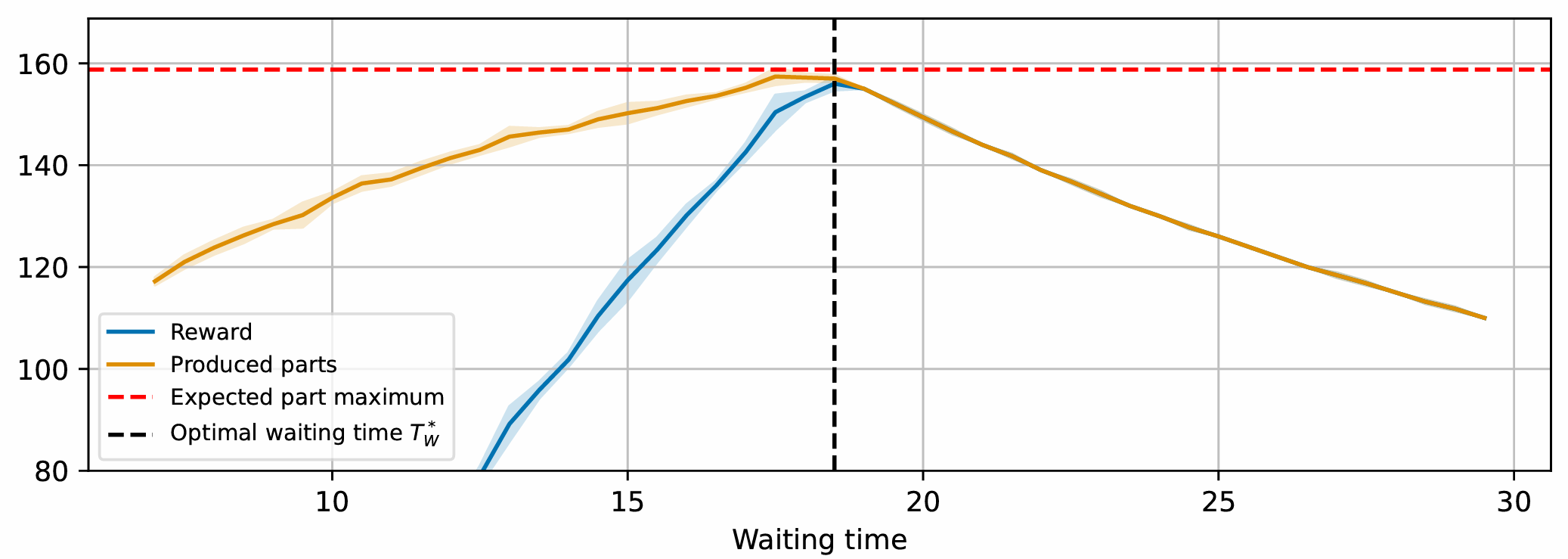Waiting Time
In this scenario, the goal is to determine the optimal waiting time between parts produced by a source station, shown in the image as S_main. This station, along with another source S_component, supplies an assembly station, displayed as Assembly, which combines components from both sources to produce the final product. Once assembled, the product moves to the Sink.
A key challenge is that components from the component source have a limited lifespan, known as the assembly condition. If too much time passes between the moment a component is prepared at the source and when the assembly process begins at the assembly, the component becomes unusable. In such cases, the assembly must discard the expired component and wait for a replacement. This not only increases costs but also disrupts the workflow, as defective components must be removed before the assembly can continue. This issue is common in processes like adhesive bonding, where adhesives can dry out if not applied within a specific timeframe.
If the waiting time between parts is too short, the source produces excess components that the assembly cannot process in time, leading to unnecessary waste. Conversely, if the waiting time is too long, the assembly is left waiting for components, delaying production. The objective is to find a balance that ensures a steady supply of components at the assembly while minimizing waste and inefficiencies.
Since the assembly is assumed to be the bottleneck in the system, the overall production rate depends on how quickly this station can receive components, assemble them, and move the assembled product to the next buffer. The optimal waiting time should match the pace at which the assembly and the source process and handle parts to maintain a continuous and efficient workflow.
What is optimized?
The processing times of the source station and the assembly station follow specific distributions. Similarly, the time required to move a component into and out of a buffer (put and get time) also follows distinct distributions. The goal is to determine the optimal waiting time at the component source, which must account for the difference between the time required by the assembly to complete processing and the time required by source to prepare its components. Essentially, the waiting time must bridge this gap to ensure a smooth workflow. By optimizing the waiting time of the component source, the earned reward (i.e. produced parts) can be maximized.
Optimization using Lineflow
We used Lineflow to optimize the production line described above. To achieve this,
we implemented A2C, PPO, Recurrent PPO, and TRPO algorithms. The maximum reward
achieved was slightly below 160, with all algorithms successfully optimizing the waiting
time and improving the reward. An explanation for the maximum reward this line can produce
is given in the following paragraph.

Verification of the optimization
In this scenario, learning a fixed waiting time is sufficient to optimize production
efficiency. The image shown below illustrates how different waiting times at the
component source impact overall system performance, i.e. the reward.
Using the parameters mentioned above, the optimum waiting time for the line is 18.5.
If this waiting time is chosen, the line can obtain a reward averaging nearly 160.
Therefore, all algorithms used can optimize the line sufficiently.
For a detailed calculation and proof of the optimal waiting time, see (Link to Lineflow paper).

Code
import numpy as np
from lineflow.simulation import (
Source,
Sink,
Line,
Assembly,
)
def make_agent_fixed_waiting_time(line, waiting_time):
waiting_times = line['S_component'].state['waiting_time'].categories
def agent(state, env):
"""
A policy that can effectively set float waiting times by
alternating between ints
"""
index = np.argmin(np.abs(waiting_times - waiting_time))
actions = {}
actions['S_component'] = {'waiting_time': index}
return actions
return agent
def compute_optimal_waiting_time(line):
time_assembly = line['Assembly'].processing_time*1.1 + 1 + 1 + 1.1
time_source = line['S_component'].processing_time*1.1 + 1.1
return time_assembly-time_source
def make_optimal_agent(line):
waiting_times = line['S_component'].state['waiting_time'].categories
processing_time_source = line['S_component'].processing_time
def agent(state, env):
"""
A policy that can effectively set float waiting times by
alternating between ints
"""
time_assembly = state['Assembly']['processing_time'].value + 1 + 1 + 1.1
time_source = processing_time_source*1.1 + 1.1
waiting_time = time_assembly - time_source
index = np.argmin(np.abs(waiting_times - waiting_time))
actions = {}
actions['S_component'] = {'waiting_time': index}
return actions
return agent
class WTAssembly(Assembly):
def __init__(
self,
name,
R=0.75,
t_jump_max=2000,
**kwargs,
):
self.R = R
self.t_jump_max = t_jump_max
self.trigger_time = None
self.factor = None
super().__init__(name=name, **kwargs)
def init(self, random):
"""
Function that is called after line is built, so all available information is present
"""
super().init(random)
self._sample_trigger_time()
def _compute_scaling_factor(self, T_jump, E=3.1):
T = self.processing_time
S = self.processing_std
T_sim = self.t_jump_max*2
return 1/T*((T_jump*(T+S+E)) / ((self.R-1)*T_sim+T_jump) - S -E)
def _sample_trigger_time(self):
self.t_jump = np.random.uniform(
0.8*self.t_jump_max,
self.t_jump_max,
)
self.factor = self._compute_scaling_factor(self.t_jump)
self.trigger_time = self.random.uniform(0.25, 0.75)*self.t_jump_max
def _sample_exp_time(self, time=None, scale=None, rework_probability=0):
"""
Samples a time from an exponential distribution
"""
coeff = self.get_performance_coefficient()
if self.trigger_time < self.env.now < self.trigger_time + self.t_jump:
factor = self.factor
else:
factor = 1
return time*factor*coeff + self.random.exponential(scale=scale)
class WaitingTime(Line):
def __init__(
self,
processing_time_source=5,
transition_time=5,
with_jump=False,
t_jump_max=None,
assembly_condition=35,
scrap_factor=1,
R=0.75,
**kwargs,
):
self.processing_time_source = processing_time_source
self.transition_time = transition_time
self.with_jump = with_jump
self.t_jump_max = t_jump_max
self.assembly_condition = assembly_condition
self.R = R
if self.with_jump:
assert self.t_jump_max is not None
super().__init__(scrap_factor=scrap_factor, **kwargs)
def build(self):
source_main = Source(
'S_main',
position=(300, 300),
processing_time=0,
carrier_capacity=2,
actionable_waiting_time=False,
unlimited_carriers=True,
)
source_component = Source(
'S_component',
position=(500, 450),
processing_time=self.processing_time_source,
waiting_time=0,
waiting_time_step=1,
carrier_capacity=1,
carrier_specs={
'carrier': {"Part": {"Assembly": {"assembly_condition": self.assembly_condition}}}
},
unlimited_carriers=True,
actionable_waiting_time=True,
)
if self.with_jump:
assembly = WTAssembly(
'Assembly',
t_jump_max=self.t_jump_max,
position=(500, 300),
R=self.R,
processing_time=20,
NOK_part_error_time=5,
)
else:
assembly = Assembly(
'Assembly',
position=(500, 300),
processing_time=20,
NOK_part_error_time=5,
)
sink = Sink('Sink', processing_time=0, position=(700, 300))
assembly.connect_to_component_input(
station=source_component,
capacity=3,
transition_time=self.transition_time,
)
assembly.connect_to_input(source_main, capacity=2, transition_time=2)
sink.connect_to_input(assembly, capacity=2, transition_time=2)
if __name__ == '__main__':
line = WaitingTime()
agent = make_optimal_agent(line)
line.run(simulation_end=4000, agent=agent)
print(line.get_n_parts_produced())